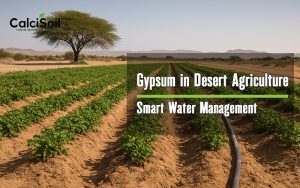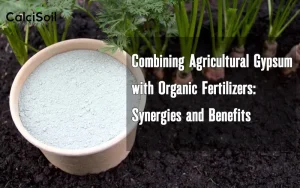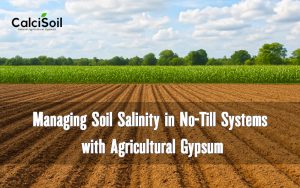
How to boost soil health
Farming in dry climates like the Middle East, North Africa, and arid parts of Asia presents unique challenges. Soils in these regions often suffer from poor structure, low organic matter, and high evaporation rates. Without proper protection, precious topsoil can be lost to wind erosion and crusting, while water evaporates before plants can use it. To combat these harsh conditions, many farmers are turning to a combination of agricultural gypsum, mulching, and cover crops—a trio that works together to enhance soil health and moisture retention sustainably.
The Role of Gypsum in Soil Improvement
Agricultural gypsum (calcium sulfate dihydrate) is a powerful soil conditioner, especially in arid environments. It improves soil aggregation, reduces compaction, and increases water infiltration. The calcium in gypsum helps flocculate soil particles, creating a crumb-like structure that allows air and water to move freely through the root zone. Additionally, gypsum helps to leach excess salts that often accumulate in dry, irrigated soils. By lowering salinity, it creates a healthier environment for roots and beneficial microbes.
When gypsum is combined with organic strategies like mulching and cover crops, its effects are amplified. Gypsum enhances the soil’s physical framework, while organic residues enrich the chemical and biological balance—together building a more resilient soil ecosystem.
Read the article “Gypsum in Desert Agriculture“.
Mulching: Reducing Evaporation and Protecting the Surface
Mulching—the practice of covering soil with organic or synthetic materials—serves as the first line of defense against heat and evaporation. In dry climates, bare soil surfaces can reach scorching temperatures, causing severe moisture loss. A mulch layer shields the soil from direct sunlight, slows evaporation, and moderates temperature swings.
When used with gypsum fertilizer, the benefits multiply. Gypsum improves water infiltration, and mulch helps retain that water in the root zone for longer. Farmers using straw, compost, or crop residues as mulch often observe better moisture balance and reduced need for frequent irrigation. Moreover, mulch protects the soil from crusting and erosion, especially during sudden desert rain events.
Cover Crops: Nature’s Living Shield

Cover crops—such as legumes, clovers, or hardy grasses—act as living mulch, providing ongoing soil cover and organic matter. In dry climates, they help prevent erosion, fix nitrogen, and add biomass to the soil once incorporated. Gypsum complements cover cropping by improving the structure and infiltration rate of the soil, allowing cover crop roots to penetrate deeper and utilize available moisture more efficiently.
When cover crops decompose, their residues interact with gypsum to stabilize soil aggregates further, creating a nutrient-rich and moisture-holding layer. This combination not only enhances fertility but also supports microbial activity and long-term carbon sequestration—key goals for sustainable dryland farming.
Integrating Gypsum, Mulch, and Cover Crops in Practice
For best results, farmers should begin with soil testing to determine gypsum requirements. Typically, applying 1–2 tons per acre of gypsum before mulching or planting cover crops gives excellent results. After spreading gypsum, it’s recommended to lightly incorporate it into the topsoil or allow irrigation or rainfall to move it downward.
Next, apply a 2–3 cm mulch layer made from crop residues, straw, or compost. Once the mulch is in place, sow cover crops suited for the local climate—species like barley, alfalfa, or vetch perform well in arid regions. Over time, this integrated system improves soil water-holding capacity, reduces compaction, and enhances fertility naturally.
Long-Term Benefits and Sustainability
The synergy of gypsum, mulching, and cover crops creates lasting benefits. Farmers report improved soil tilth, higher organic carbon, and increased resilience against drought and salinity. The system reduces the need for chemical inputs, promotes biodiversity, and improves water-use efficiency—a vital advantage in desert and semi-desert farming systems.
Over several seasons, soils treated with this combination show improved infiltration rates, reduced runoff, and stronger root growth. By capturing and retaining more moisture, farms can thrive even under limited irrigation, leading to more sustainable and profitable agriculture.
Conclusion
In dry climates, where every drop of water counts, integrating agricultural gypsum, mulching, and cover crops offers a proven strategy for soil protection and long-term productivity. Gypsum enhances structure and drainage, mulch conserves water, and cover crops bring life and nutrients back to the soil. Together, they form a natural defense system that supports both crop yields and environmental sustainability.







